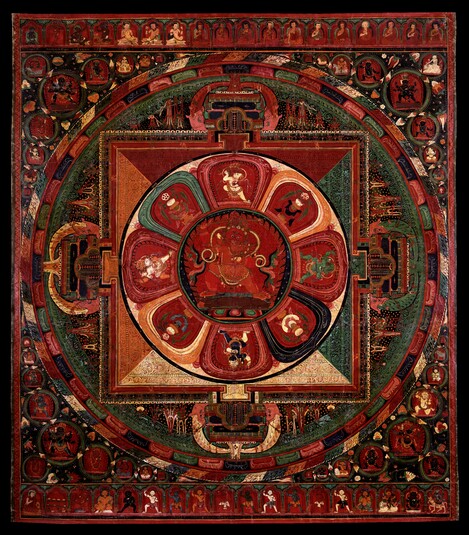
Item: Mandala of Yamari, Rakta (Buddhist Deity) - (Virupa Lineage, 5 Deity)
| Origin Location | Tibet |
|---|---|
| Date Range | 1400 - 1499 |
| Lineages | Sakya and Buddhist |
| Size | 88.90x76.84cm (35x30.25in) |
| Material | Ground Mineral Pigment on Cotton |
| Collection | Rubin Museum of Art |
| Catalogue # | acc.# P2001.18.3 |
Classification: Deity
Appearance: Wrathful
Gender: Male
Rakta Yamari Five Deity Mandala (Tibetan: shin je she mar po kyil khor lha nga. English: the Red Enemy of Death): an emanation of the wisdom bodhisattva Manjushri.
Sanskrit: Rakta Yamari Tibetan: Shin je she mar
Tibetan: Shin je she mar
Within the center of the two-dimensional circular diagram (mandala) representing the top view of a three-dimensional celestial palace is the wrathful deity Rakta Yamari embracing the consort Vajra Vetali. With one face and two hands the right hand holds aloft a vajra stick ready to strike and the left a skullcup held to the heart; embracing the consort. Very fierce in appearance with the hair flowing upward like fire, large eyes and a gaping mouth, the right leg is bent and the left extended standing above a black corpse and a reclining red buffalo. The consort, Vajra Vetali, stands on the right leg with the left wrapped around the partner. Holding a skullcup in the left hand she exhibits a fierce demeanor. They both wear bone and jewel ornaments, silk garments, a necklace of heads and a lower garment of tiger and leopard skin; completely surrounded by the flames of pristine awareness.
Surrounding the central Yamari in the four main directions - above (west) is red Raga Yamari embracing the consort white Sarasvati. To the right (north) is green Irshya Yamari embracing the consort light green Gauri, below (east) is white Moha Yamari embracing the consort black Carcika, to the left (south) is yellow Matsarya Yamari embracing the consort light yellow Varahi. In each of the four intermediate directions above a pink lotus is an initiation vase tied with a silk ribbon and topped with a skullcup. Surrounding the mandala figures is the geometric form of a celestial palace placed squarely on a double vajra (Sanskrit: visvavajra) with only the prongs and makara heads (an Indian mythological sea creature) appearing on the four sides. The structure is surrounded by a circle of lotus petals and five coloured flames.
Along the top of the painting starting from the left side with the primordial buddha Vajradhara are the Indian gurus of the Rakta Yamari initiation and practice lineage. Third from the left is Virupa, in typical iconographic form, with the hand raised to the sun.
In the Sarma Schools there are three main forms of Rakta Yamari: (1) the solitary figure Rakta Yamari. The subject of this present painting is known as the (2) Rakta Yamari with Five Deities and lastly the (3) Rakta Yamari with Thirteen Deities of the Shridhara lineage. All of these are found in the 17th chapter of the Rakta Yamari Tantra.
The Main Indian Lineage: Vajradhara, Manjushri Yamari, Jnanadakini, mahasiddha Virupa, Dombi Heruka, Viratipa, Matigarbha, Gambhiramati, Vajrasana Ashokashri, Nishkalangka Devi, Revendra Prabha, Chag Lotsawa Choje Pal (Tibetan), etc. There were many lineages of Rakta Yamari to enter Tibet and most are traced back to Virupa.
The painting style is Nepali indicated by the bright colours and lack of shading along with the tight detailed lotus patterns surrounding the figures within the mandala.
The painting was made in memory of the teacher Kunga Legpa.
Also look to the Zimmerman Family Collection in Art of the Himalayas, Treasures From Nepal and Tibet, the American Federation of Arts. Hudson Hill Press, New York, 1991 (ISBN: 1-55595-067-1). Mandala of Raktayamari, page 152, #85. This Zimmerman painting has an almost identical inscription on the back dedicated to the same person Kunga Legpa: byang phug pa bla ma dam pa mkhas btsun kun dga' legs pa'i thugs dam la bzhengs pa yin.
Jeff Watt 5-2003
Front of Painting
English Translation of Inscription: Name inscriptions for all the figures in the top and bottom registers.
Reverse of Painting
Wylie Transliteration of Inscription: byang phug pa bla ma kun dga'' legs pa''i thugs dam la gzhengs pa yin lags. svo.
Special Features: (Printed script (Uchen), is black, includes "Om Ah Hum" inscription)
Mandala: Mandala Main Page
Tradition: Sakya Deity Paintings
Mandalas: Sakya Tradition
Collection of Rubin Museum: Mandala Masterworks
Buddhist Deity: Yamari, Rakta (Mandalas)
Buddhist Deity: Yamari, Rakta (with corpse)
Mandala: Masterworks Page
Buddhist Deity: Yamari, Rakta (Iconography & Religious Context)
Buddhist Deity: Yamari, Rakta (Religious Context)
Buddhist Deity: Yamari, Rakta, Main Page
Buddhist Deity: Yamari, Rakta (Masterworks)
Mandala: Sakya Masterworks


